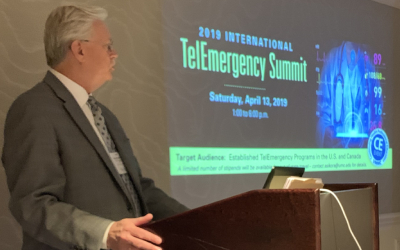Emergency Telemedicine
- UMMC Center for Telehealth Home
- Program Director's Welcome
- Emergency Telemedicine
- Behavioral Health
- Extended Reality
- Electronic Resources
-
Project ECHO
- Project ECHO Home
- Center for the Advancement of Youth ECHO Training
- Critical Care Project ECHO
- Dermatology Training
- General Neurology ECHO
- Pediatric Dentistry
- Pediatric Genetics ECHO
- Sexually Transmitted Diseases in the Community ECHO
- Teaching Educators About Child Behavioral Health (TEACH) Program
- Frequently Asked Questions
- Contact Us
Emergency Telemedicine
 Over the last decade, emergency telemedicine (ET) delivery has seen increased adoption rates throughout the United States. By providing two-way audiovisual consultation between patients and providers from a central emergency department (ED) hub to geographically remote EDs, ET provides opportunities to improve the quality of emergency care at rural hospitals that often have limited medical resources and lack trained emergency providers. Currently, several healthcare systems provide ET services which annually account for over tens of thousands of consultations. One of the standard goals of emergency medicine, as a specialty, has been to create parity and consistency in the practice of EM across all venues and should also be a target objective in considering priorities in ET research and development of practice guidelines.
Over the last decade, emergency telemedicine (ET) delivery has seen increased adoption rates throughout the United States. By providing two-way audiovisual consultation between patients and providers from a central emergency department (ED) hub to geographically remote EDs, ET provides opportunities to improve the quality of emergency care at rural hospitals that often have limited medical resources and lack trained emergency providers. Currently, several healthcare systems provide ET services which annually account for over tens of thousands of consultations. One of the standard goals of emergency medicine, as a specialty, has been to create parity and consistency in the practice of EM across all venues and should also be a target objective in considering priorities in ET research and development of practice guidelines.
Despite the growth of ET services, only slight evidence exists to support the clinical and cost effectiveness of ET. This is due to a lack of controlled trials, as well as, a lack of consensus for standard metrics by which ET delivery is evaluated. These knowledge gaps have led to payor and policy maker decisions limiting the widespread adoption of ET in the United States.
In order to identify the best supporting evidence, determine knowledge gaps, develop a consensus on standard metrics, and predict future directions for ET delivery, a consensus meeting with nationally recognized ET clinical and research experts was held in April of 2019. Utilizing an implicit approach for consensus development, experts addressed the following priority issues:
- Determine the state of the evidence for best practices in ET and identify top questions that can provide supporting evidence.
- Determine the research priorities for ET, identify knowledge gaps, and propose priority research studies to address gaps in evidence.
- Identify future directions of ET, including standards of practice, use of new tools, government policy implications, developing trends, and opportunities that could lead to increased adoption.
The Tel-Emergency Summit was held on Saturday, April 13, 2019, as a satellite event in conjunction with the ATA Conference in New Orleans. The primary purpose of the summit was to develop a consensus among emergency telemedicine experts on the current state of evidence, including: best supporting evidence, priority knowledge gaps, barriers to essential data, and future challenges.


